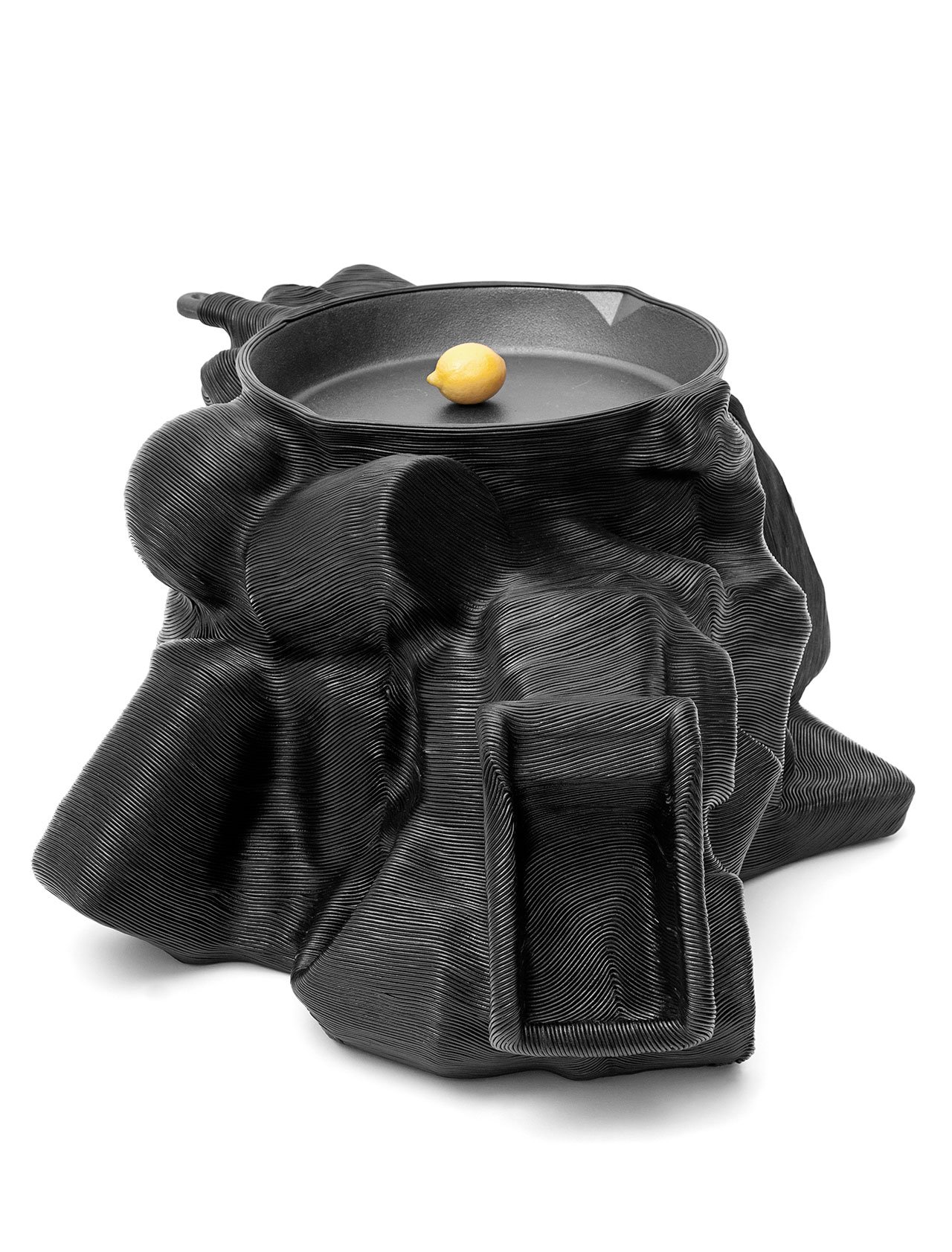
Savage Side Table - Black Edition.
Cowhide Leather, Mundane Objects.
Photo by Travis Roozee. © Jay Sae Jung Oh.
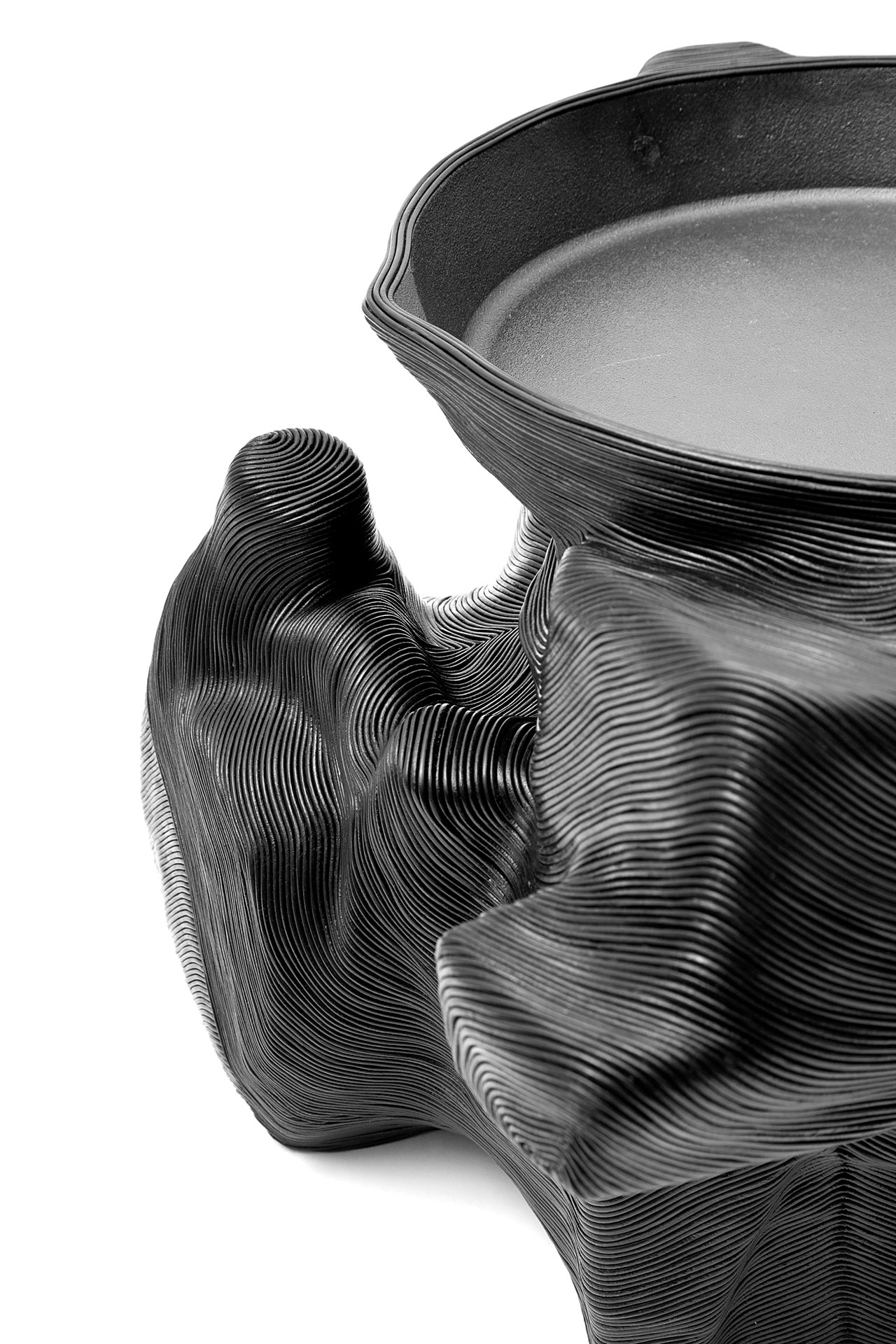
Savage Side Table - Black Edition (detail).
Cowhide Leather, Mundane Objects.
Photo by Travis Roozee. © Jay Sae Jung Oh.
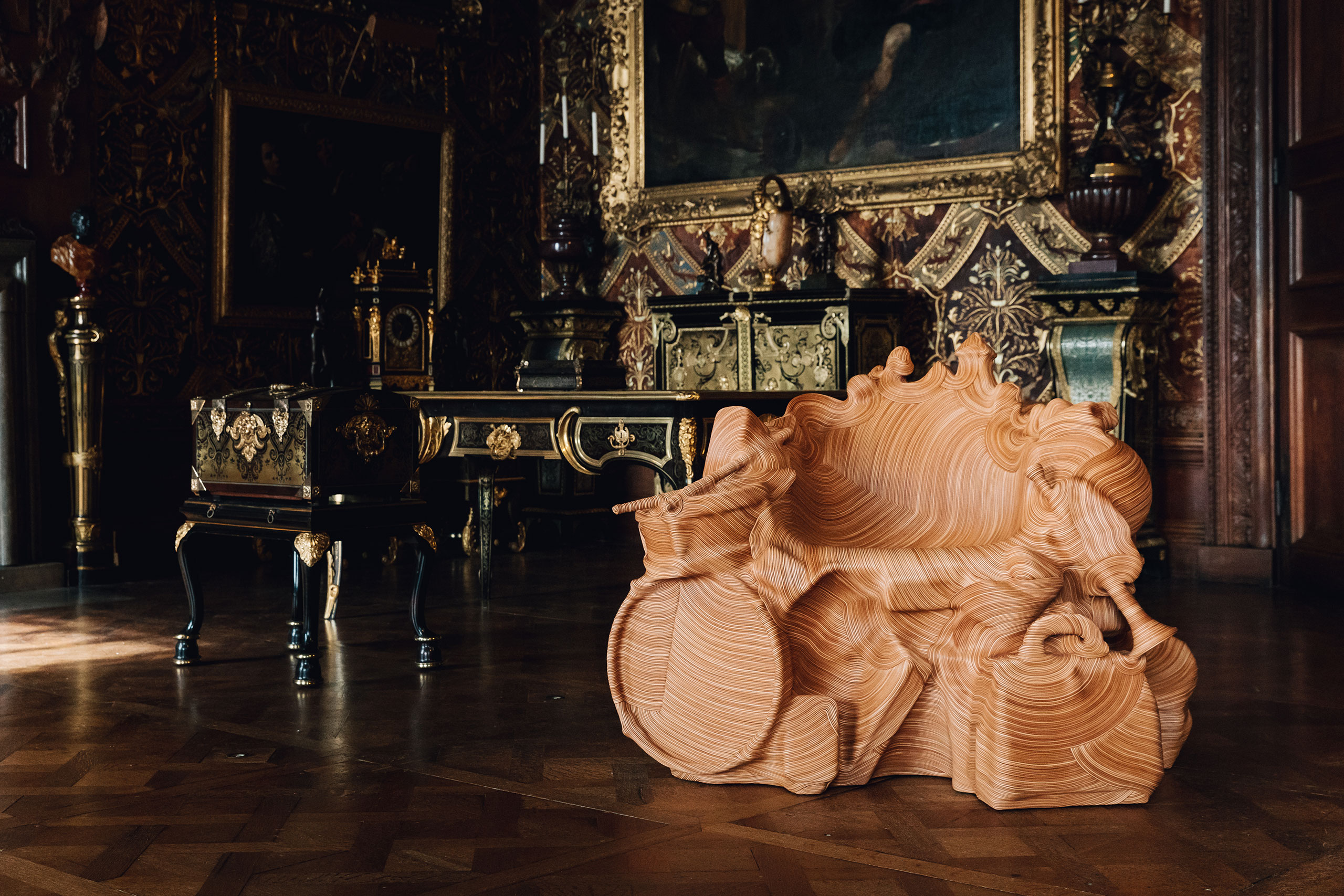
Installation view. "Mirror Mirror: Reflections on Design at Chatsworth". Image courtesy of Jay Sae Jung Oh and Chatsworth House Trust. © Chatsworth House Trust. Photo by India Hobson.
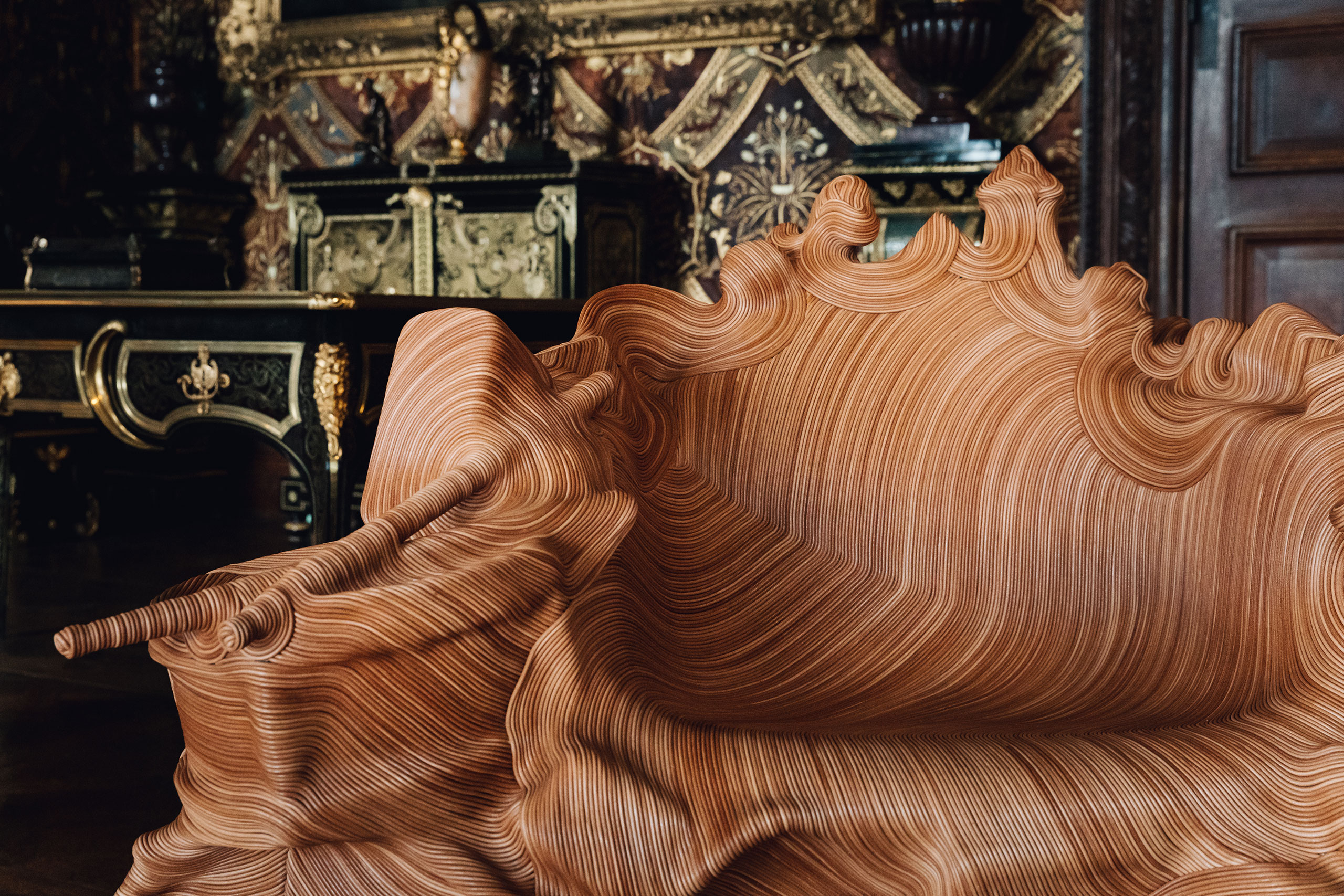
Installation view. "Mirror Mirror: Reflections on Design at Chatsworth". Image courtesy of Jay Sae Jung Oh and Chatsworth House Trust. © Chatsworth House Trust. Photo by India Hobson.
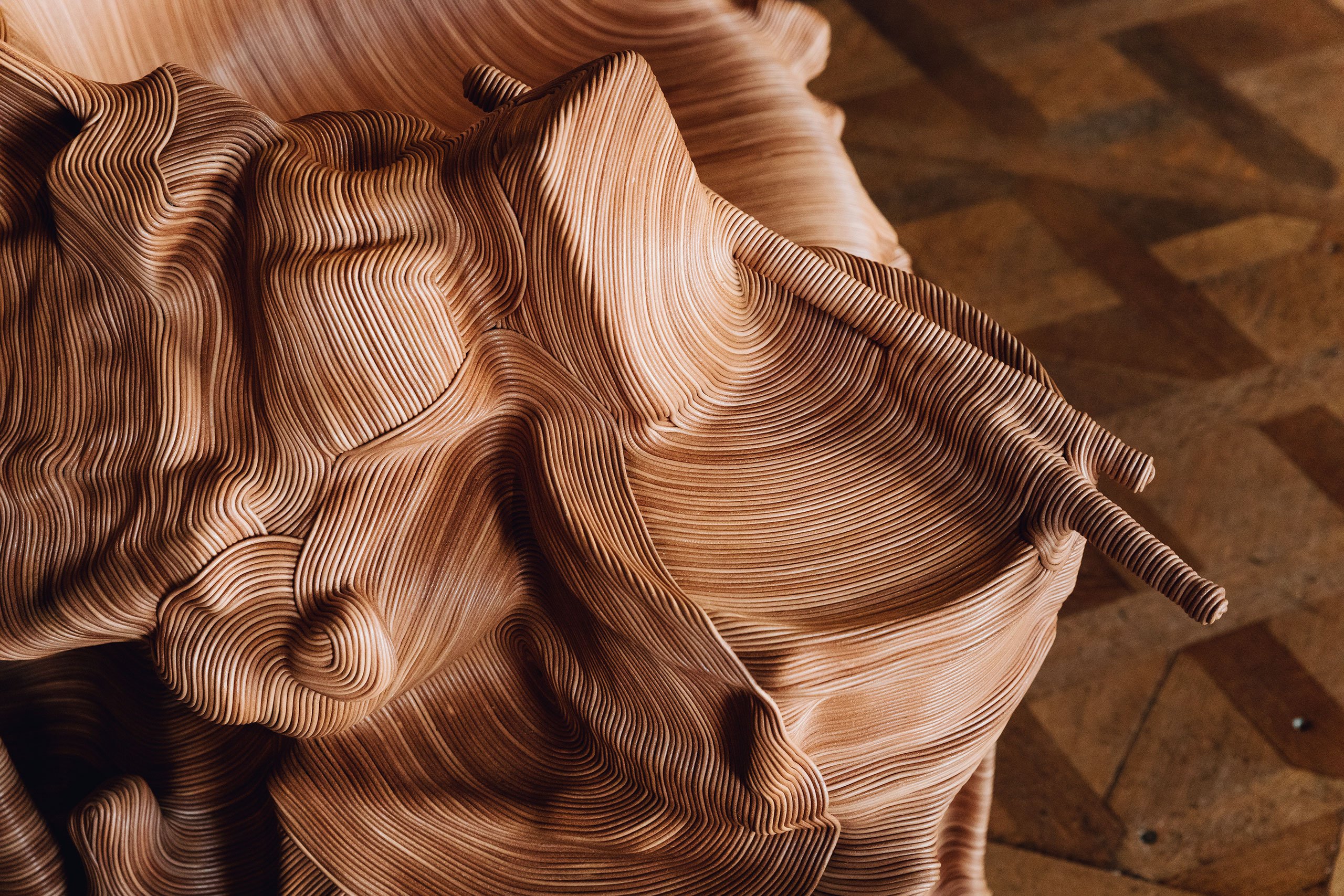
Installation view. "Mirror Mirror: Reflections on Design at Chatsworth". Image courtesy of Jay Sae Jung Oh and Chatsworth House Trust. © Chatsworth House Trust. Photo by India Hobson.
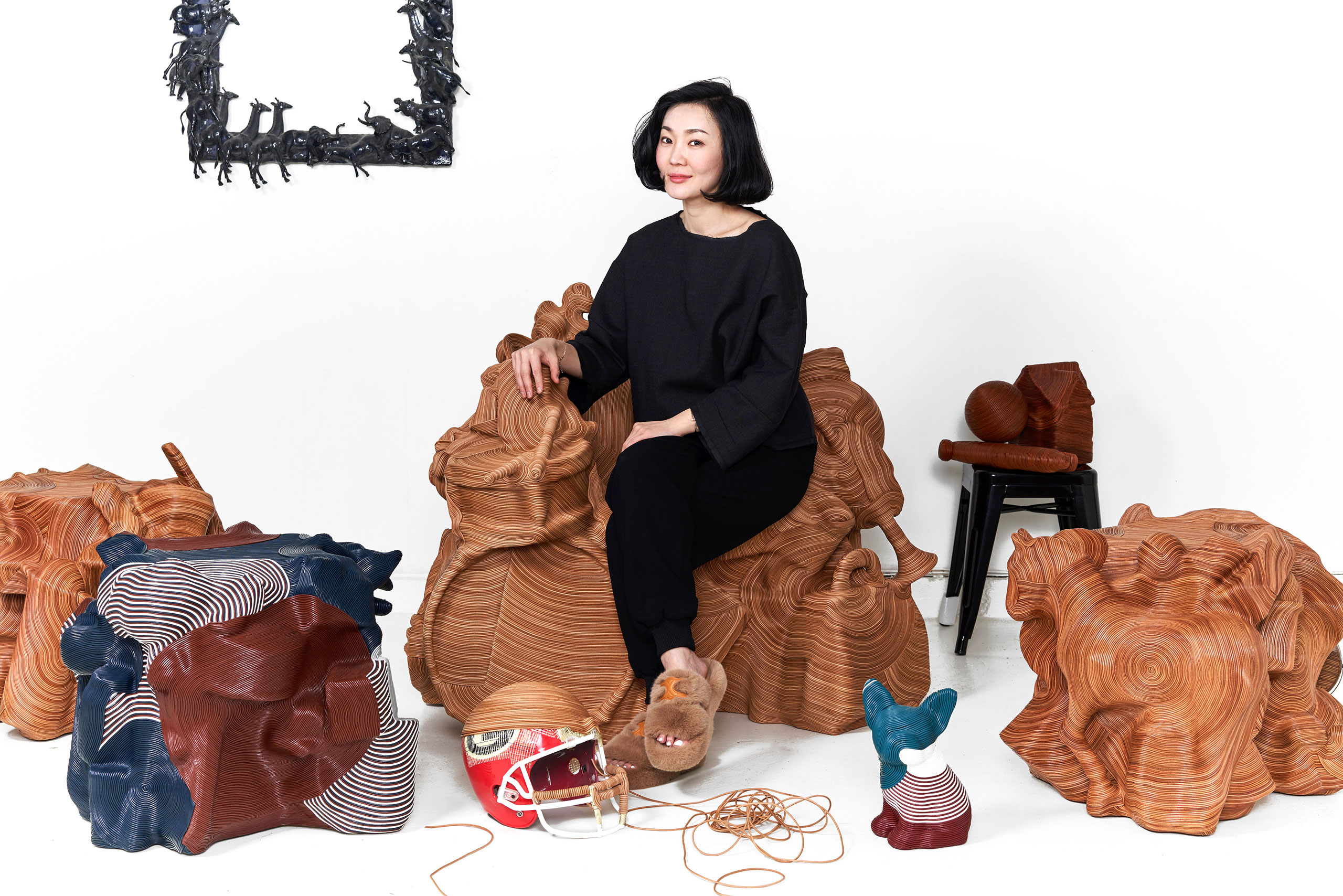
Jay Sae Jung Oh at her Seatle Studio. Courtesy of the artist and Salon94 Design. Photo by Ian Allen. © Jay Sae Jung Oh.
The idea for the Savage series started a decade ago when Jay was studying industrial design at Michigan’s Cranbrook Academy of Art which she pursued after her fine arts degree in Seoul in order to reach a wider audience with her work. On her way to the design studio, there were two huge dumpsters which she noticed were filling up super quickly, partly with the discarded prototypes she and her fellow students were making for big furniture companies. It didn’t take long for her to begin thinking about her own role in producing so much waste and our consumerist culture at large. “People are always buying something new,” she says, “they don’t really appreciate what they already have so they keep throwing things away”. Instinctively, she started collecting objects from the dumpsters, such as broken chairs, trays and pots that were still usable or had an interesting form. At first, there was no masterplan, “I don’t even know why I did it”, Jay confesses – fellow students joked that she was making her own dumpster in the design studio – but she soon came up with the idea to give them a new lease of life as a way to question their obsolescence.
To do so, Jay turned to natural materials and hand-craftsmanship – the antithesis of the mass-produced products that we so easily discard. Using plant-based jute rope she experimented with wrapping techniques, starting with a simple detergent box. “People couldn’t stop touching it, rubbing it, hugging it”, she remembers. For her next pieces, she combined multiple objects into a small side table, which captured top honours at the Design Quest 2011 Furniture Design Competition, and a chair for her graduation show which also won her praise and is now part of the Cranbrook Art Museum’s collection.
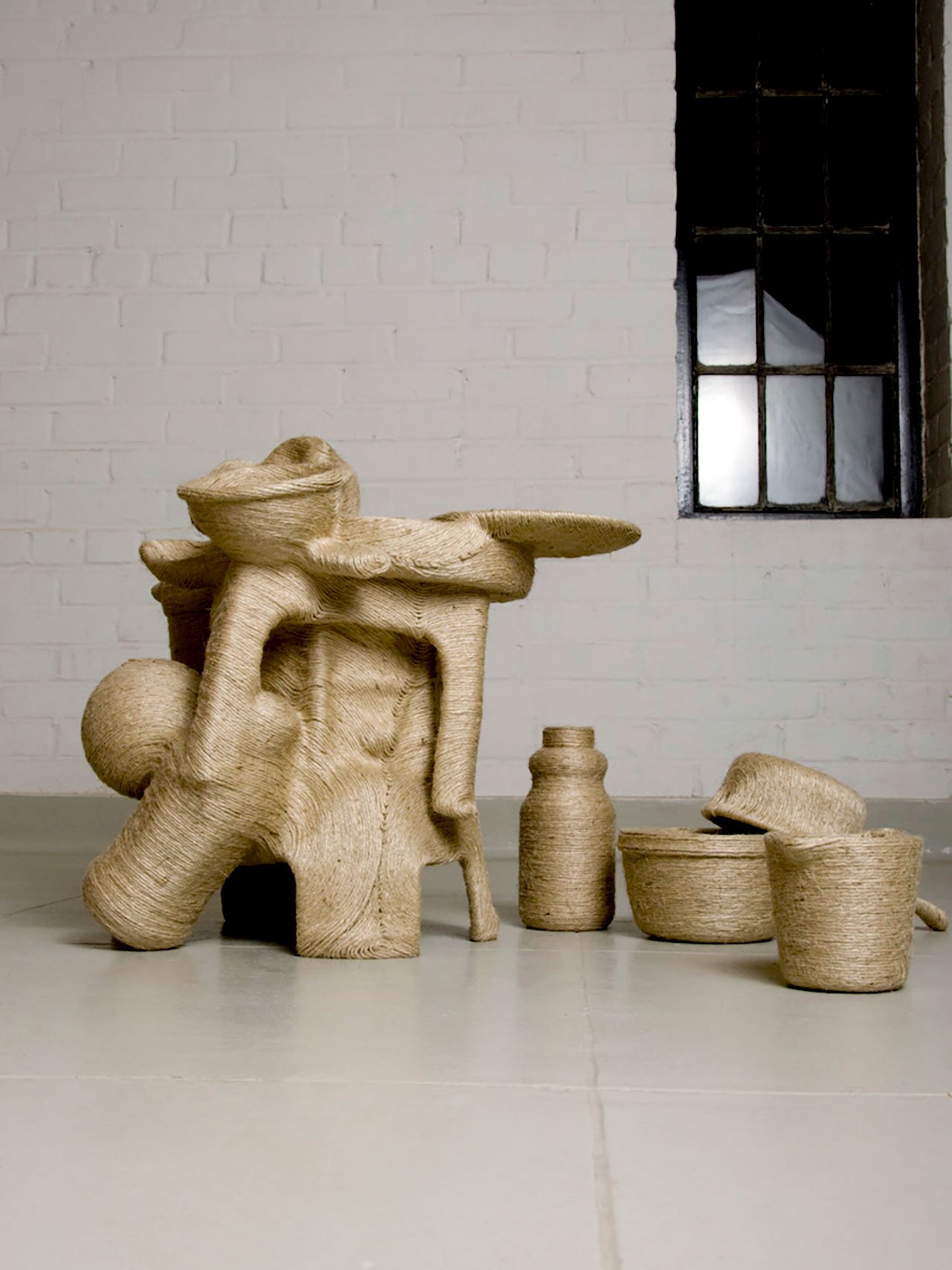
Jute Side Table, 2011.
© Jay Sae Jung Oh.
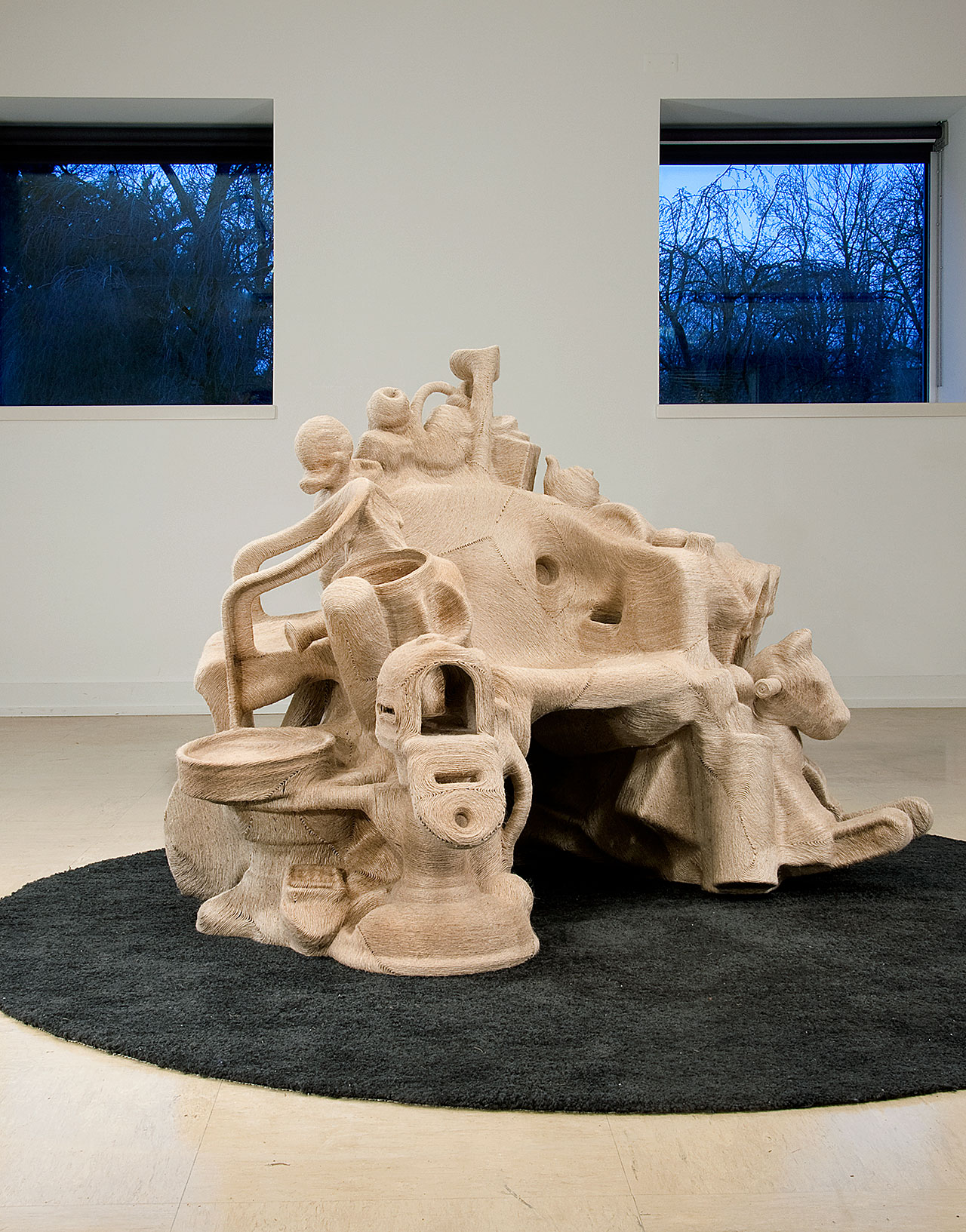
Savage Chair - Jute, 2011.
© Jay Sae Jung Oh.
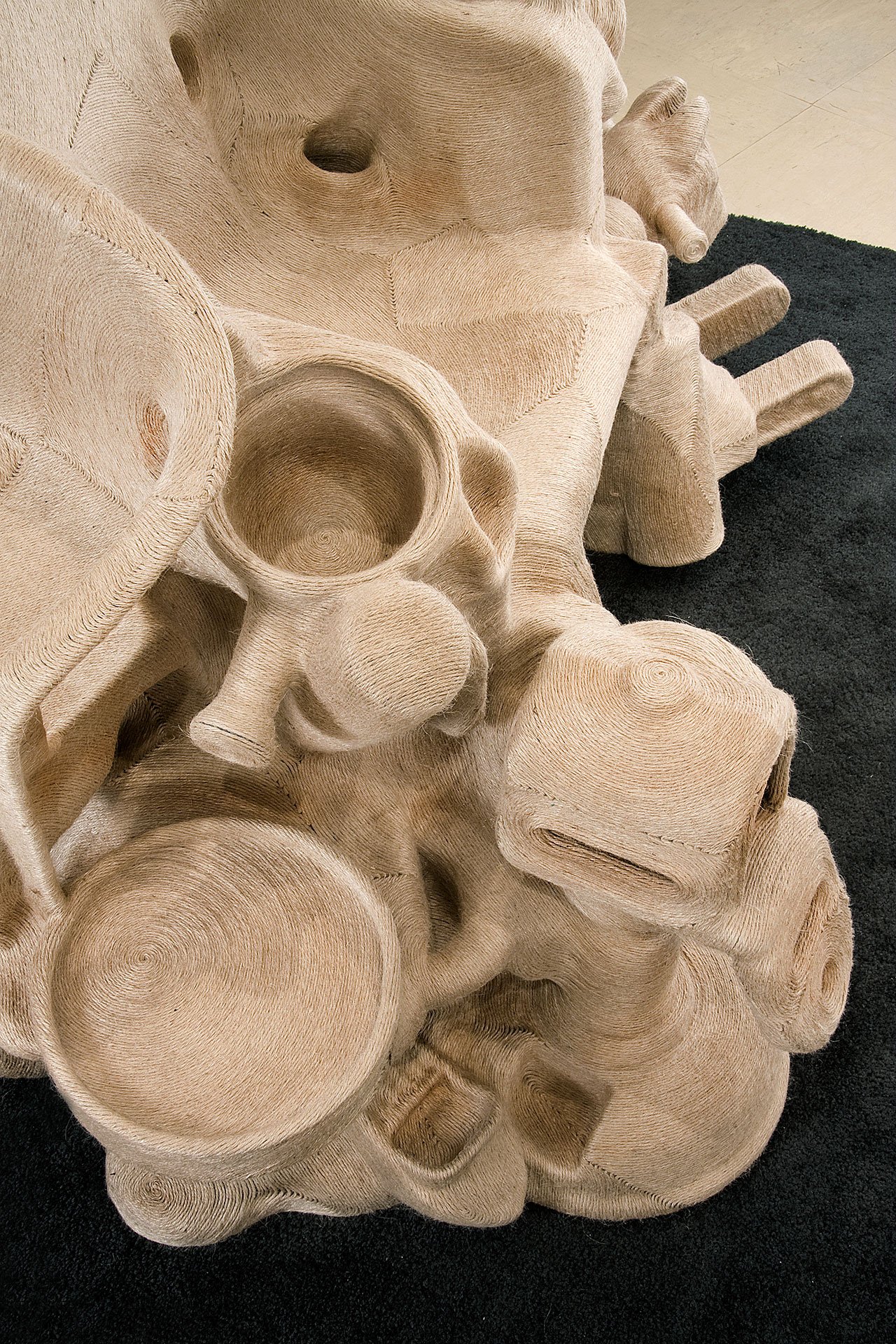
Savage Chair - Jute (detail), 2011.
© Jay Sae Jung Oh.

Savage Stool E1 - Raw Edition 2019.
Photo by Amanda Ringstad. © Jay Sae Jung Oh.
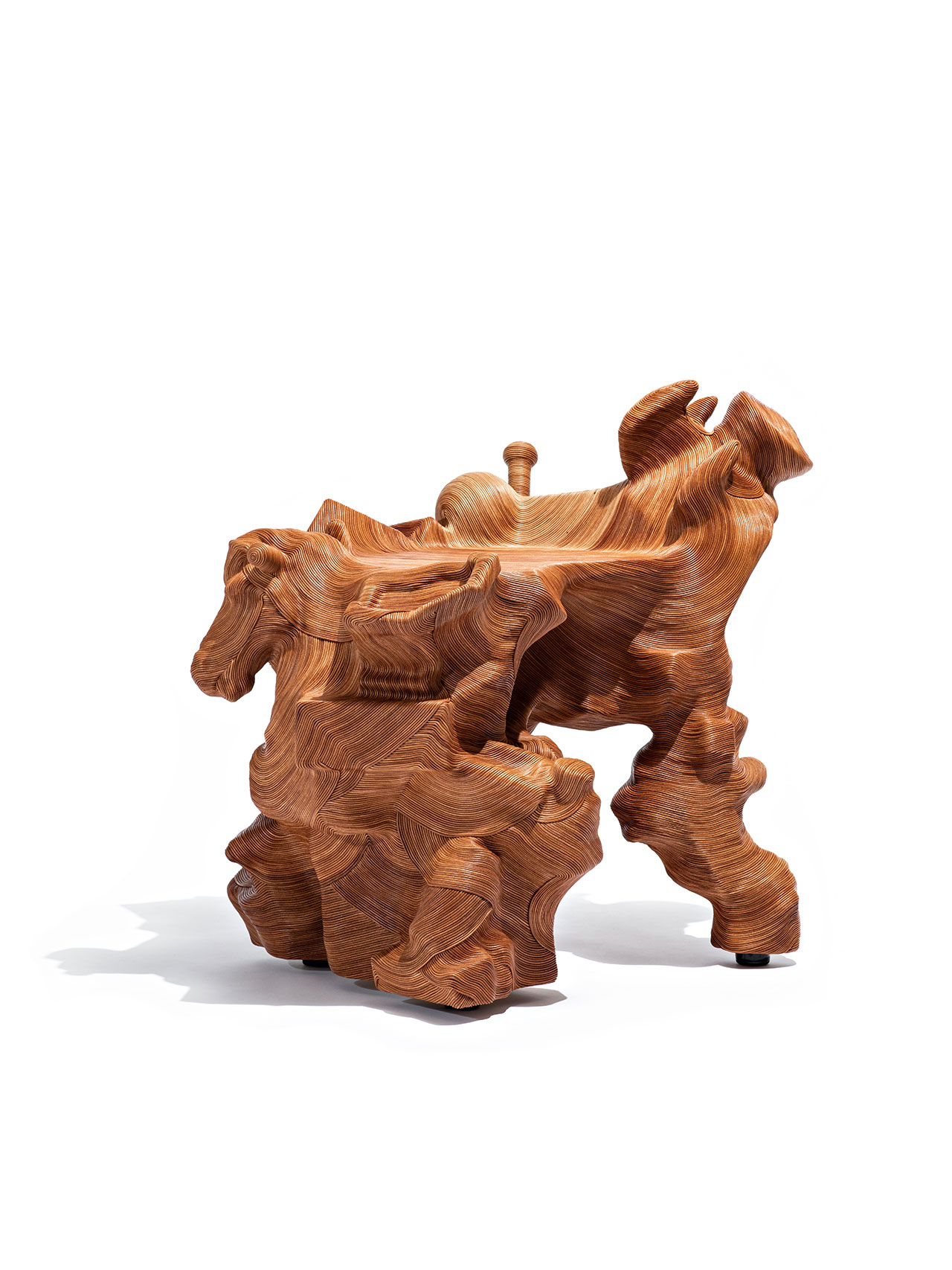
Savage Stool E1 - Raw Edition, 2019.
Photo by Amanda Ringstad. © Jay Sae Jung Oh.
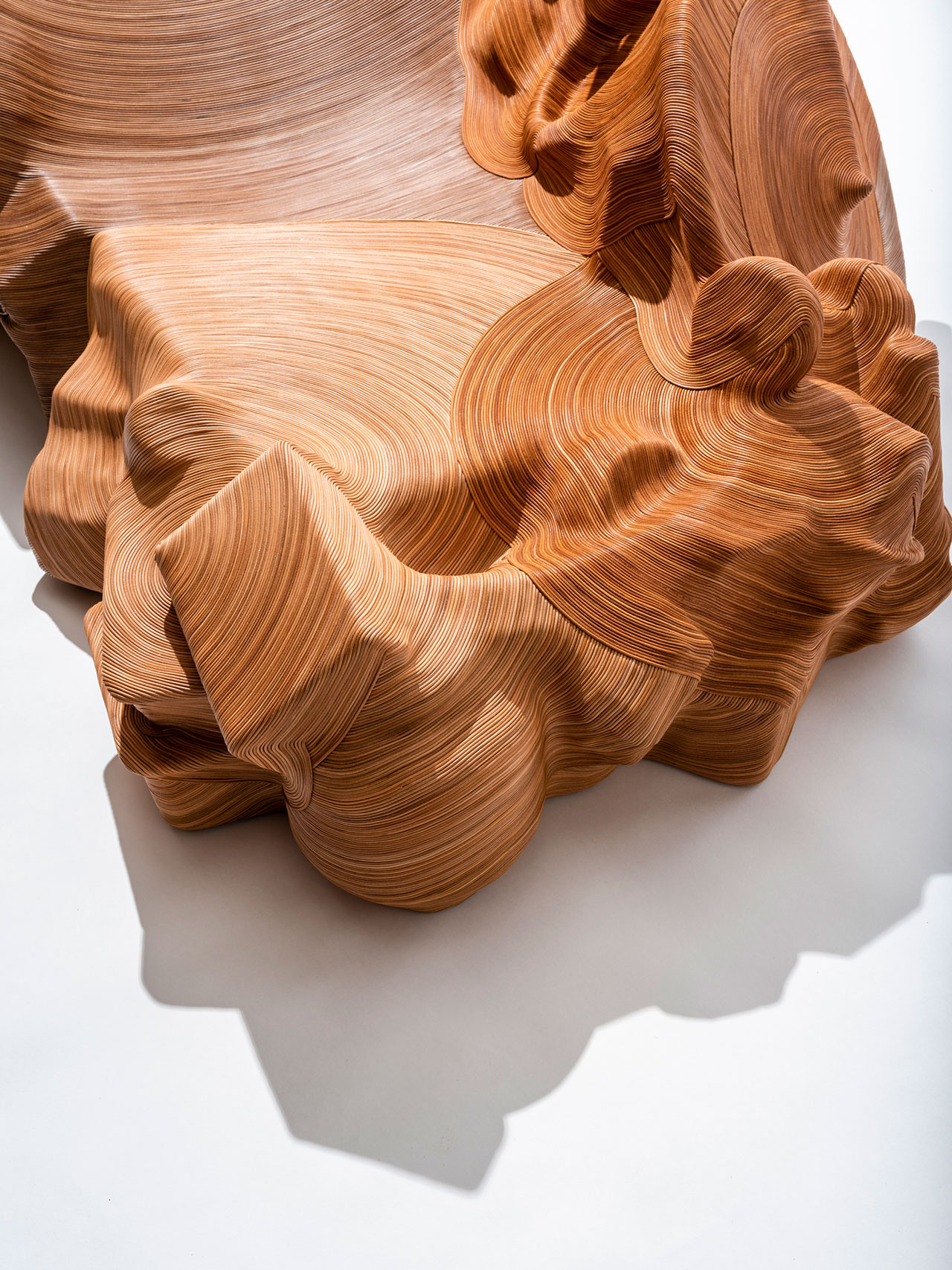
Savage Stool E1 - Raw Edition ,2019.
Photo by Amanda Ringstad. © Jay Sae Jung Oh.
The success of those first pieces led to Jay’s gallery representation in New York helping her continue working on the series which she has been doing ever since, something she says she could never have imagined back then. “Of course, a lot of developments happened during that time”, she adds, such as using different materials, most notably cowhide leather, and coming up with new wrapping techniques and creating new patterns. “It takes a long time, a really long time”, Jay says when asked how time-consuming the crafting process is, especially in the early days before she developed methods to speed it up a bit.
“The most fun part for me is playing with the objects”, she tells Yatzer, “making them into a structure”. It’s also the most important part of the crafting process, not just in terms of structural stability but also regarding functionality – the pieces have to be as functional as they are beautiful. “When it comes to art, there’s an invisible barrier that forbids us from getting close to it”, she explains; in contrast, “design is all about our everyday life, we can use it, touch it”. As haphazardly assembled as they may appear, every piece has been carefully designed to effectively serve its purpose. “People wonder if they can sit there”, she says about the Savage chairs, sofas and stools, “but once you do, it’s really comfortable!”

Savage Series Black Edition Sofa, 2016.
Cowhide Leather, Mundane Objects.
Photo by Travis Roozee. © Jay Sae Jung Oh.

Savage Series Black Edition Sofa, 2016.
Cowhide Leather, Mundane Objects.
Photo by Travis Roozee. © Jay Sae Jung Oh.

Savage Sofa and Side Table - Black Edition.
Cowhide Leather, Mundane Objects.
Photo by Travis Roozee. © Jay Sae Jung Oh.
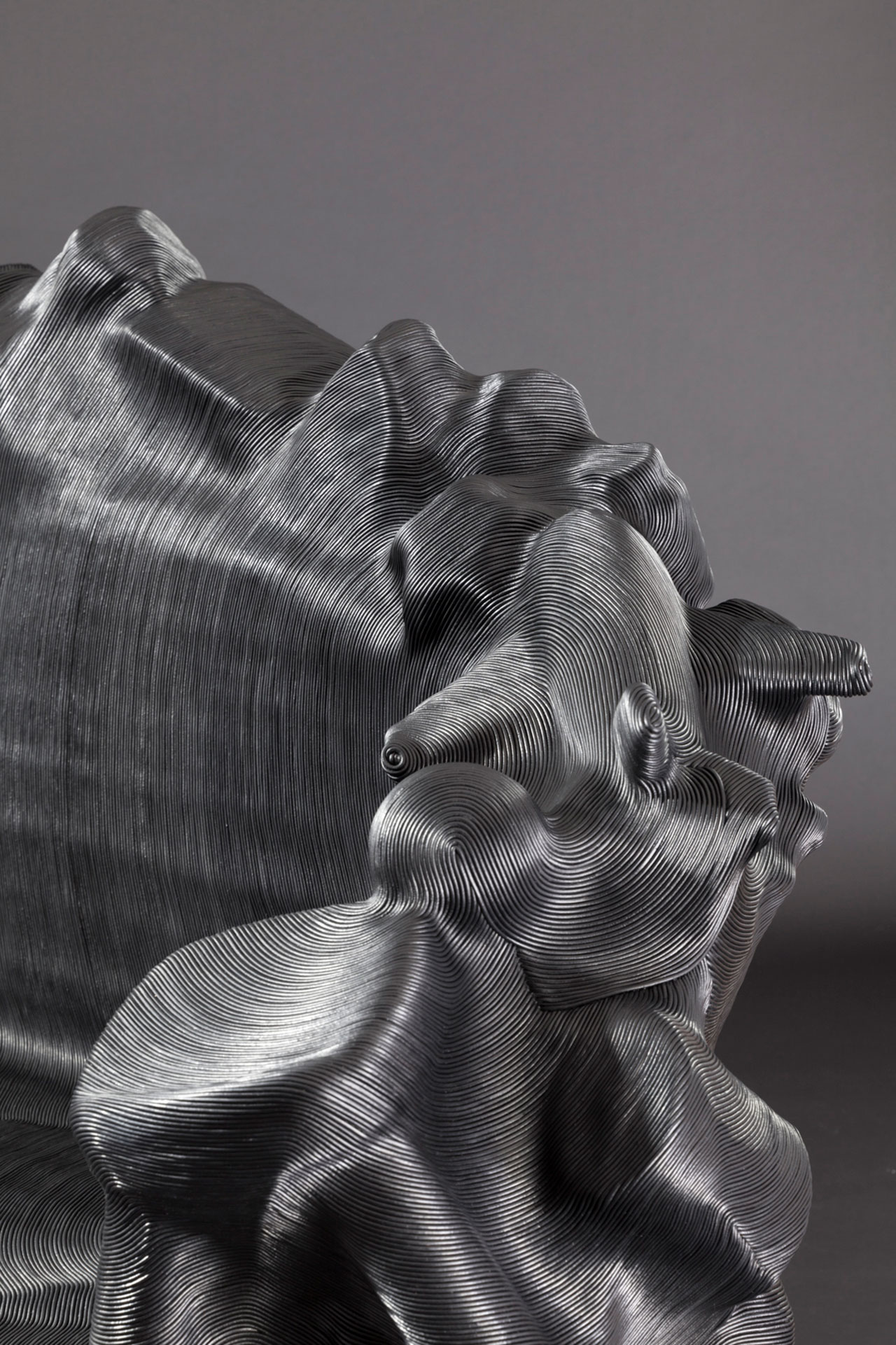
Savage Series Black Edition Sofa (detail), 2016.
Cowhide Leather, Mundane Objects.
Photo by Travis Roozee. © Jay Sae Jung Oh.
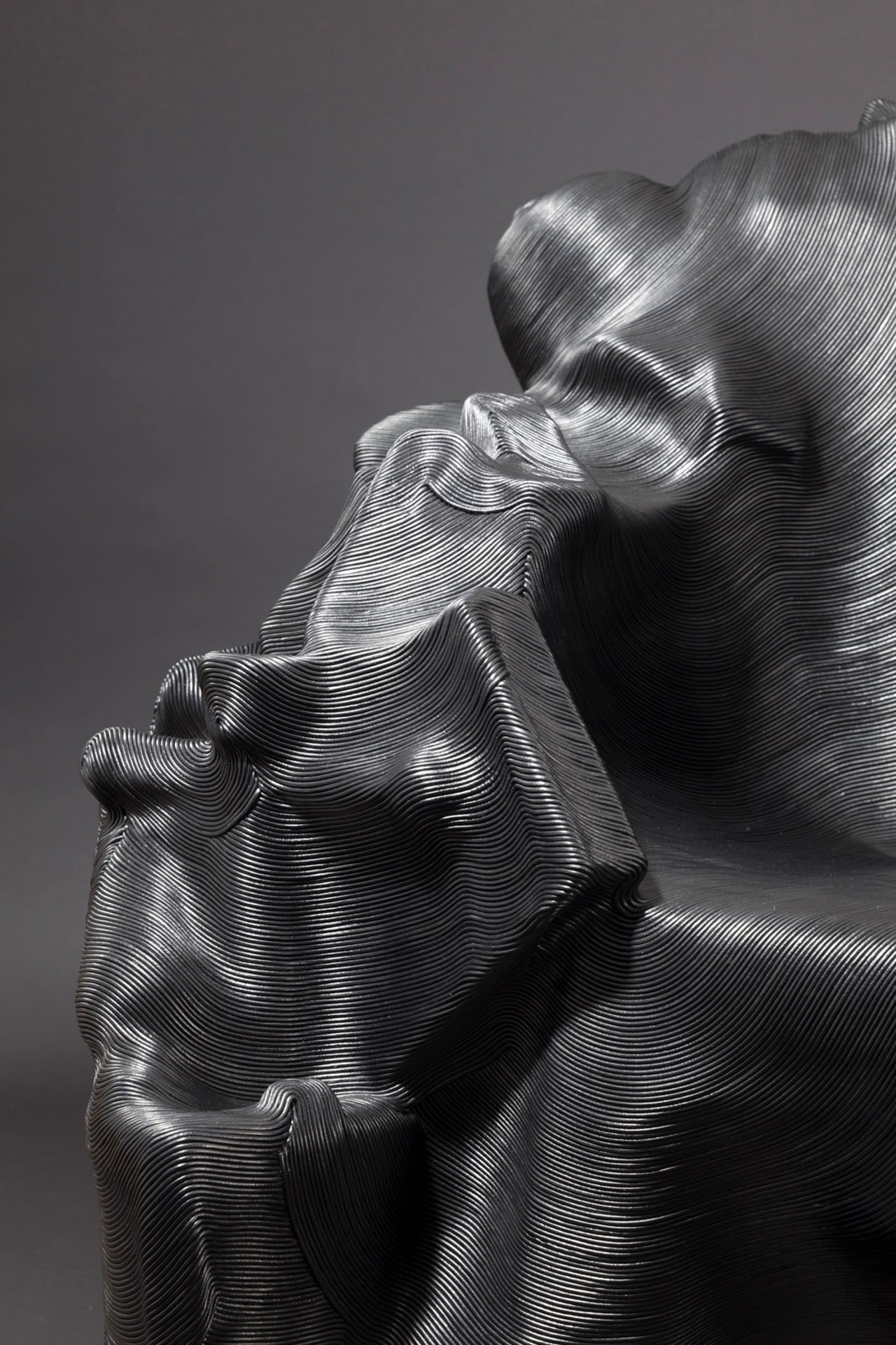
Savage Series Black Edition Sofa (detail), 2016.
Cowhide Leather, Mundane Objects.
Photo by Travis Roozee. © Jay Sae Jung Oh.
When it comes to sourcing materials, she’s happy to report that she no longer goes through dumpsters, as there’s a steady stream of donations from friends and neighbours. Sometimes she also goes treasure hunting visiting thrift shops that sell by the pound. “My garage is always fulI!” she excitedly says. Donated, bought or found, it’s important to consider, she adds, what these objects mean to people – “they represent our history, our memories and our culture”. This is why precious things from her own life sometimes make their way into her work, most recently, into a “wall organizer” made entirely with personal objects, which made it quite difficult to let go when it was immediately sold in the gallery show it was first exhibited at.
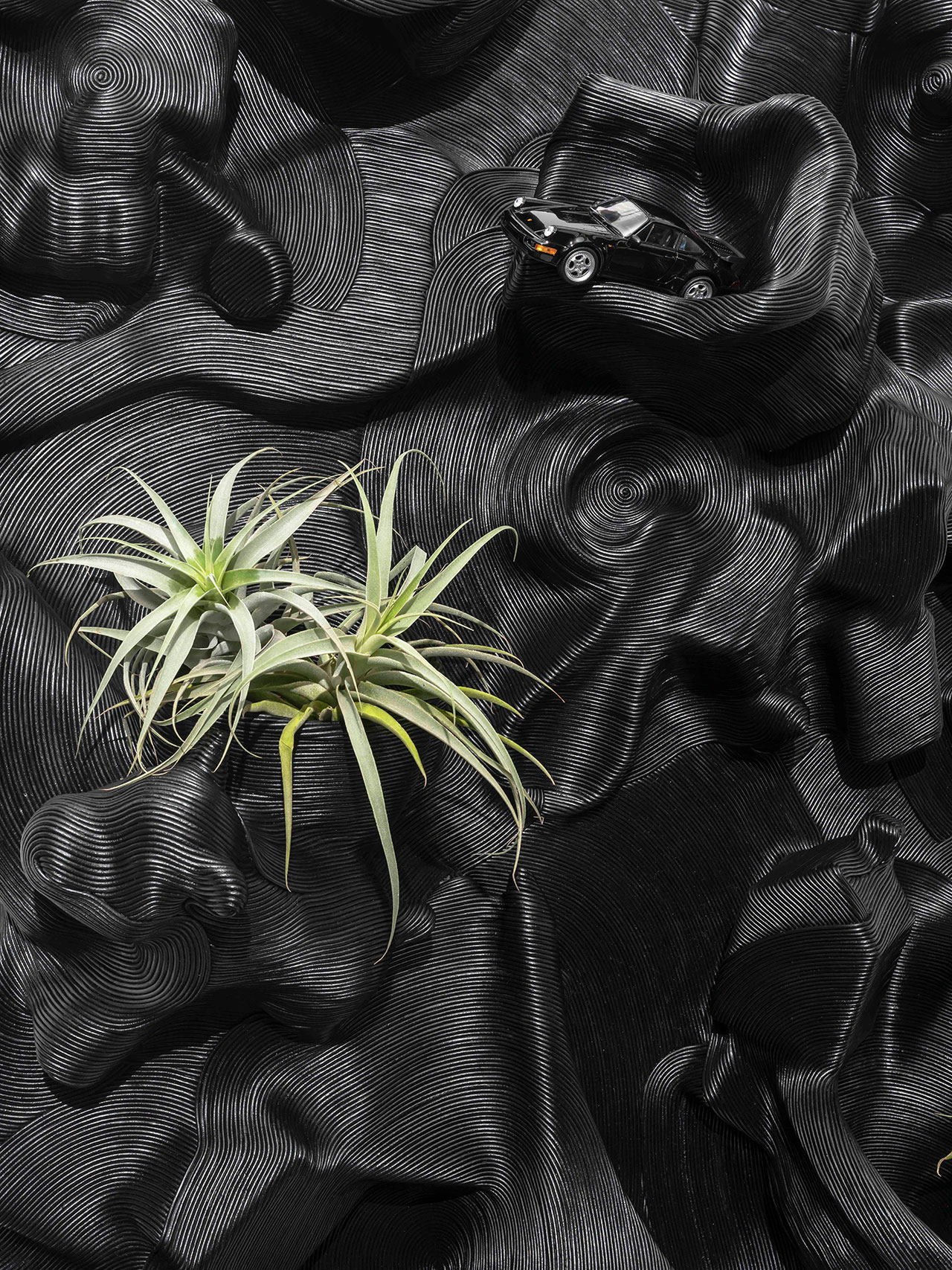
Savage Wall Organizer - Black Edition (detail).
Photo Amanda Ringstad. © Jay Sae Jung Oh.

Savage Wall Organizer - Black Edition.
Photo by Amanda Ringstad. © Jay Sae Jung Oh.
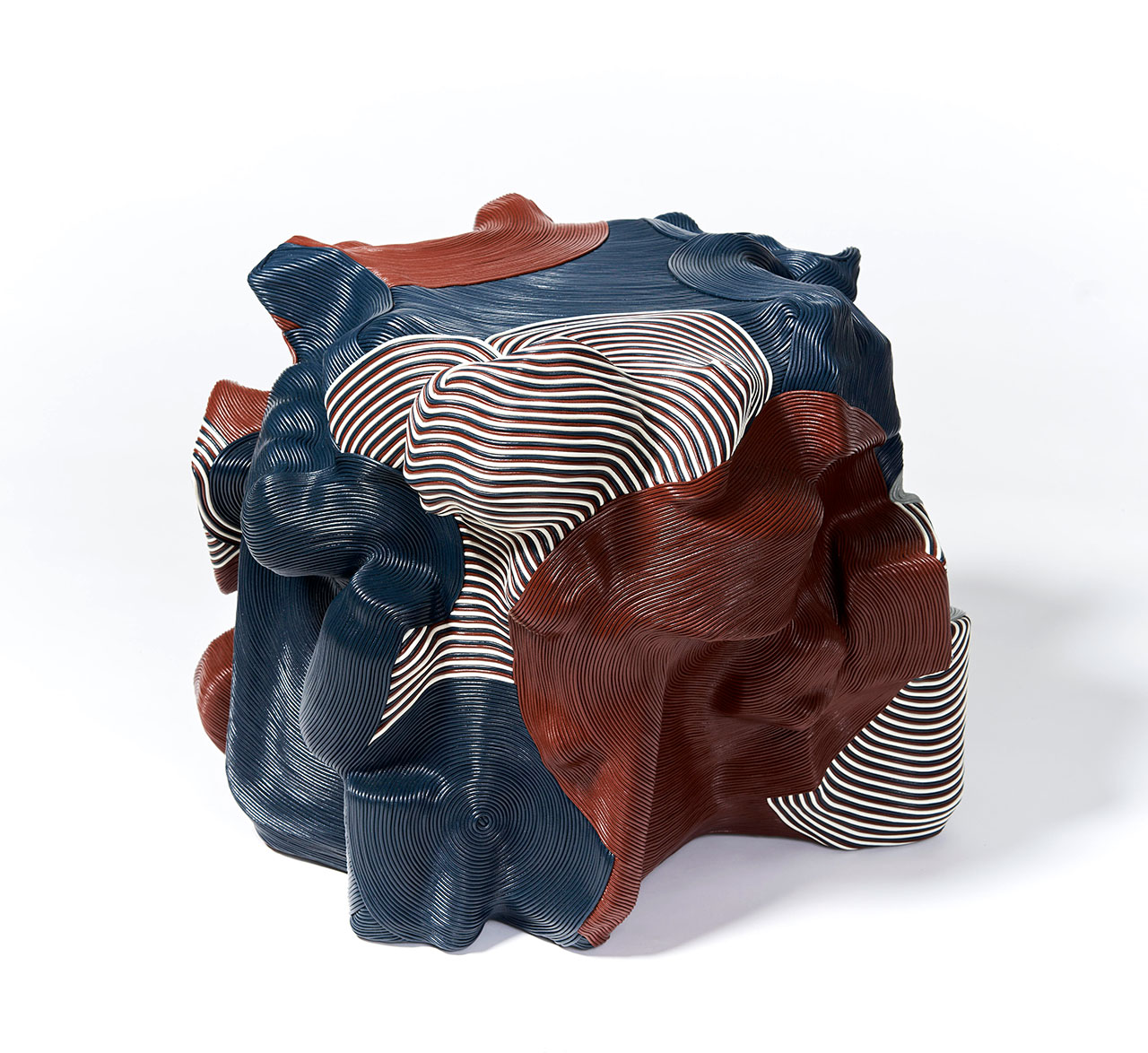
Salvage Stool, 2022.
Various plastics, leather cord.
Photo by Ian Allen. © Jay Sae Jung Oh.
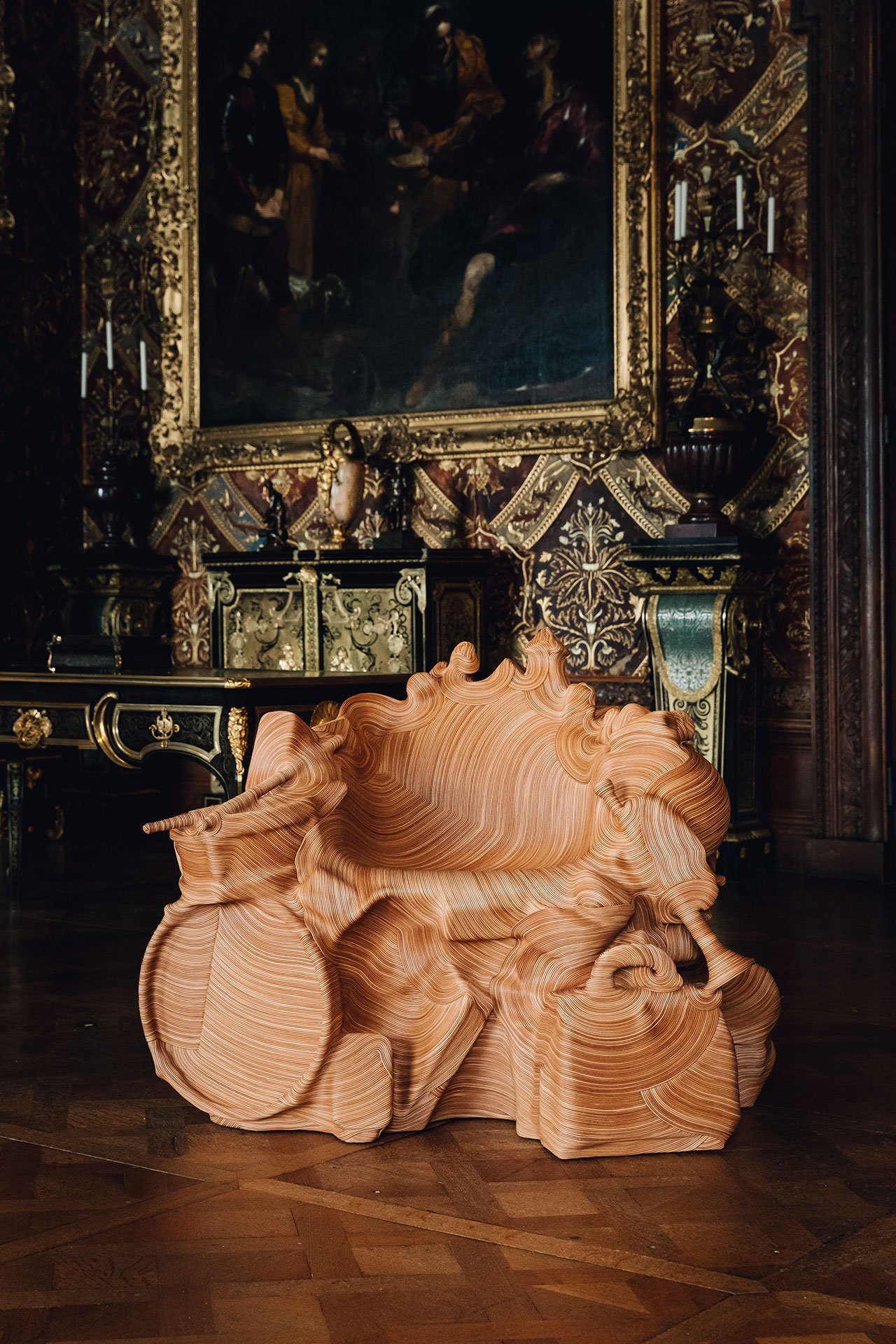
Installation view. "Mirror Mirror: Reflections on Design at Chatsworth". Image courtesy of Jay Sae Jung Oh and Chatsworth House Trust. © Chatsworth House Trust. Photo by India Hobson.
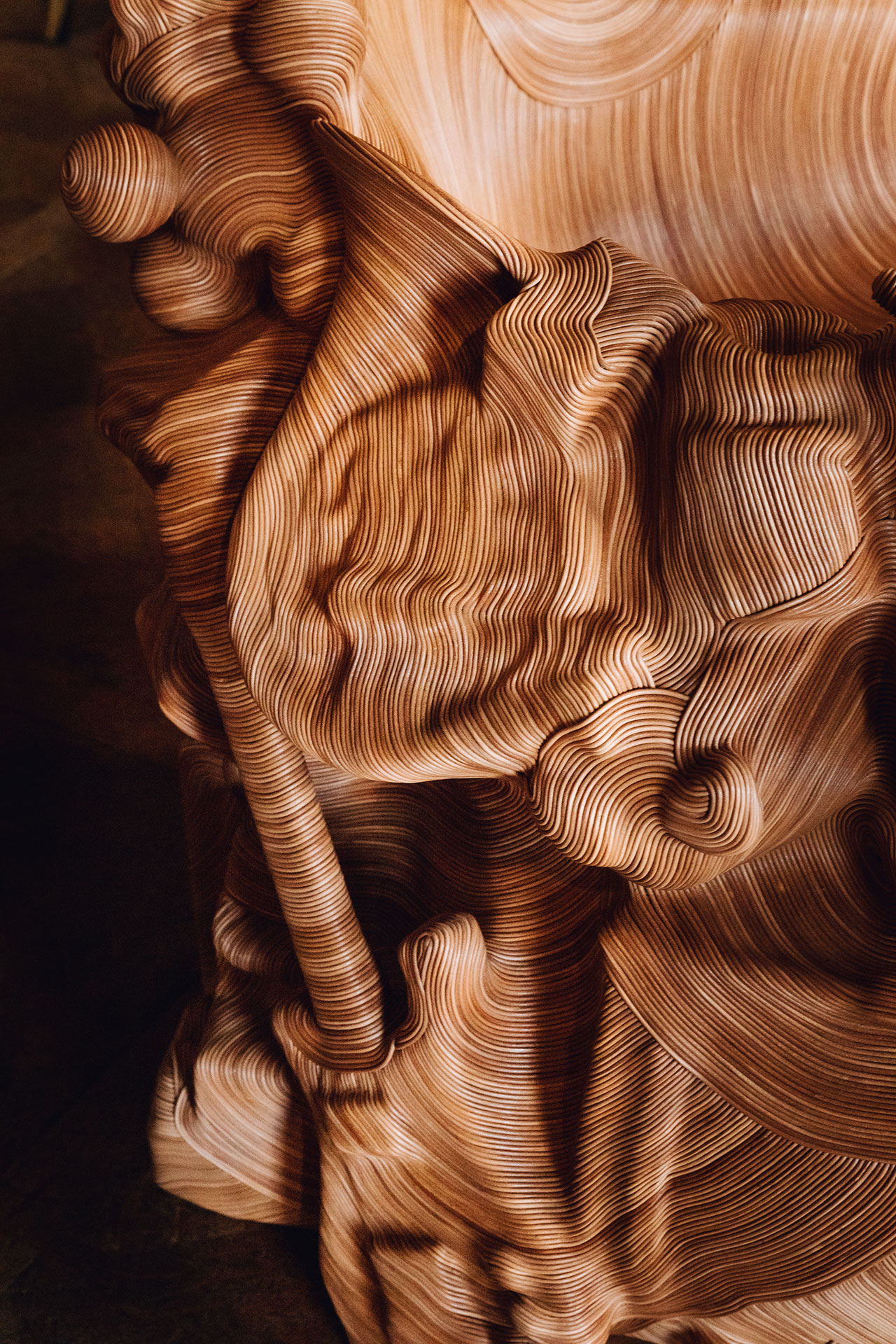
Installation view. "Mirror Mirror: Reflections on Design at Chatsworth". Image courtesy of Jay Sae Jung Oh and Chatsworth House Trust. © Chatsworth House Trust. Photo by India Hobson.
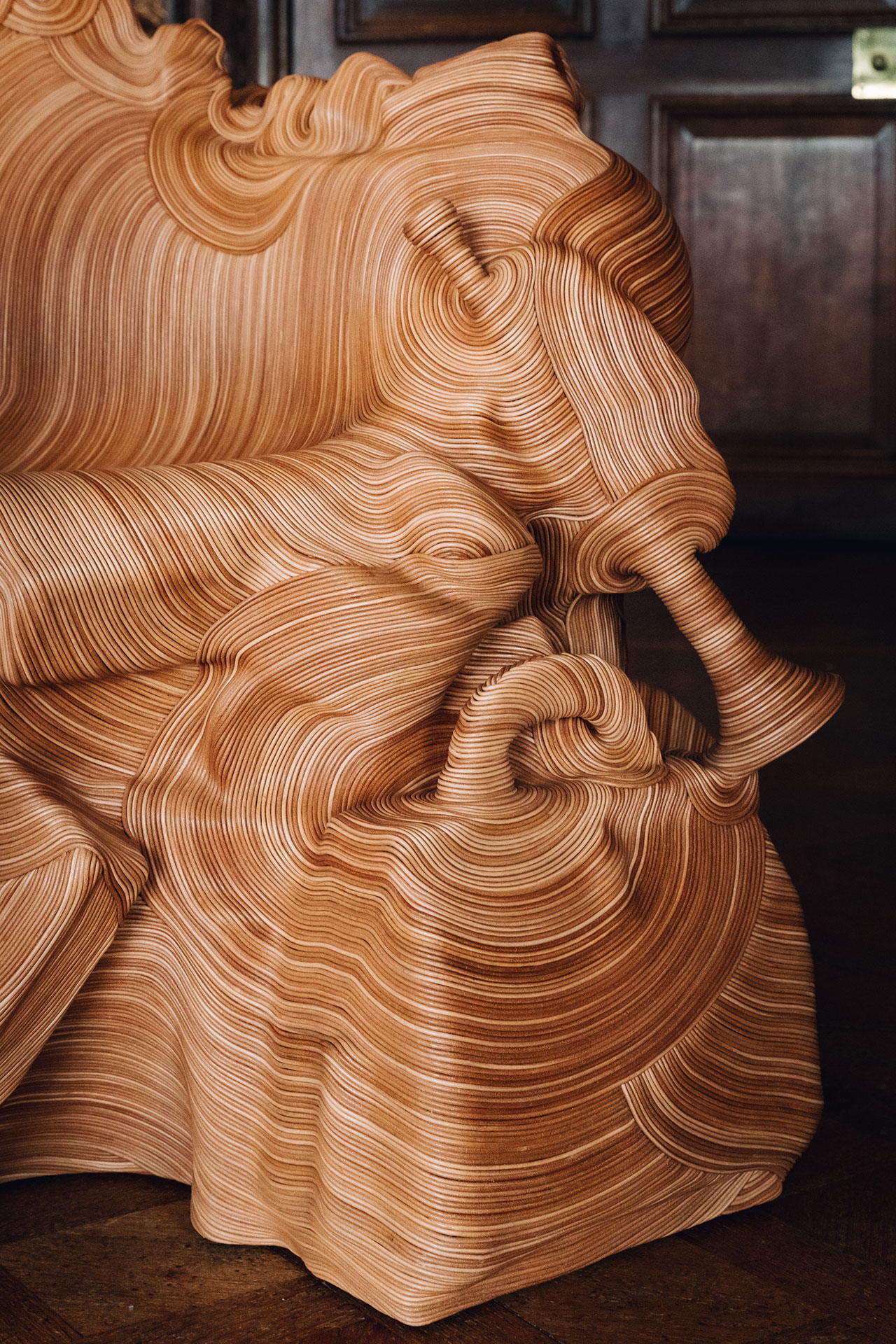
Installation view. "Mirror Mirror: Reflections on Design at Chatsworth". Image courtesy of Jay Sae Jung Oh and Chatsworth House Trust. © Chatsworth House Trust. Photo by India Hobson.
For her latest piece for the exhibition Mirror Mirror: Reflections on Design at Chatsworth House, Jay used a hodgepodge of broken musical instruments, including a French horn, a snare drum, and an electric guitar, to create a one-of-a-kind throne inspired by the historic setting. Displayed in Chatsworth’s State Music Room, the sinuous patterns and tangled forms of the Salvage Series Chatsworth Chair converse with the room’s gilded antiques and ornate decorations.
More than ten years on since the Savage series begun, Jay hasn’t lost any momentum, on the contrary, she’s as creative as ever, already preparing for her next solo at Salon 94 Design in New York scheduled for January 2024, and at the same time, running her pet brand Boo Oh, which she launched in 2013 when Boo, an adorable French bulldog, came into her life and she couldn’t find products she liked. Needless to say, all products are handmade using quality natural materials, meticulously designed down to the last detail. Nothing less than you’d expect from a designer who champions sustainability over mass production.
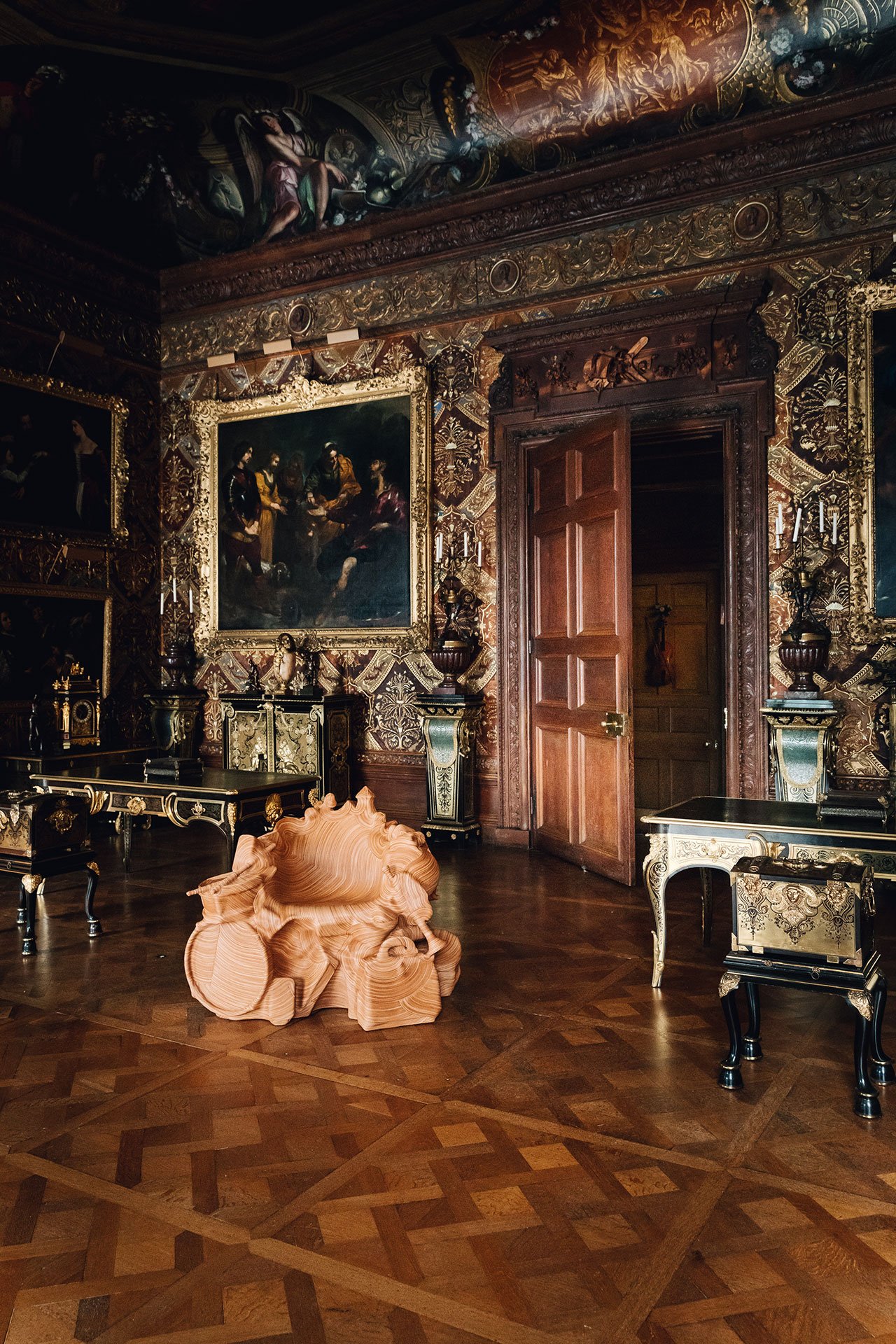
Installation view. "Mirror Mirror: Reflections on Design at Chatsworth". Image courtesy of Jay Sae Jung Oh and Chatsworth House Trust. © Chatsworth House Trust. Photo by India Hobson.

Installation view. "Mirror Mirror: Reflections on Design at Chatsworth". Image courtesy of Jay Sae Jung Oh and Chatsworth House Trust. © Chatsworth House Trust. Photo by India Hobson.

Installation view. "Mirror Mirror: Reflections on Design at Chatsworth". Image courtesy of Jay Sae Jung Oh and Chatsworth House Trust. © Chatsworth House Trust. Photo by India Hobson.

Installation view. "Mirror Mirror: Reflections on Design at Chatsworth". Image courtesy of Jay Sae Jung Oh and Chatsworth House Trust. © Chatsworth House Trust. Photo by India Hobson.

Installation view. "Mirror Mirror: Reflections on Design at Chatsworth". Image courtesy of Jay Sae Jung Oh and Chatsworth House Trust. © Chatsworth House Trust. Photo by India Hobson.
















